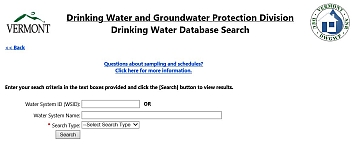Public Community Water Systems
Public Community drinking water systems are defined in the Vermont Water Supply Rule as a public water system which serves at least 15 service connections used by year-round residents or regularly serves at least 25 year-round residents. Essentially, any source or combination of sources of water which has the ability to serve at least 25 individuals or 15 residential connections through a common distribution system is considered a community water system. Community water systems in Vermont range from small 15 connection condominium associations to the largest cities, and encompasses everything in between.
Community systems include condominium associations, fire districts, municipal entities, mobile home parks, co-housing associations, and home owners associations. If you are considering building a new community system or transitioning from an existing TNC or NTNC system into a community system, please contact the DWGWPD capacity program. Community systems are also required to provide Consumer Confidence Reports yearly.
Non-Transient Non-Community (NTNC) Water Systems
NTNC systems are defined by the Vermont Water Supply Rule as a public water system that is not a public community water system and that regularly serves at least 25 of the same person daily for more than six months per year. This is interpreted to apply to all non-residential systems that serve at least 25 of the same people for six months or more. NTNC systems can include schools, daycares, office buildings and factories, assuming they all serve 25 or more of the same people (students/staff/employees) for six months or more.
Requirements for Systems
Community and NTNC Systems are subject to the following, including but not limited to:
Water system officials must maintain an updated contact list utilizing the WATER SYSTEM OFFICIALS CONTACT FORM.
- Monthly Operating Reports
- Having a valid Permit to Operate
- Having a certified operator of the same class of the system or greater
- Having regular sanitary surveys every 2.5 - 3 years
- Adherence to primary drinking water quality standards and the necessary monitoring that comes with that requirement
- Updating its Source Protection Plan every three years
- Demonstrating that the systems have the technical, managerial and financial capacity to operate the system.
- Planning improvements to an NTNC or Community System- you may need a construction permit.
- Adding a new source, or hydrofracturing deepening of an existing source, or any increase in withdrawal from an existing source. to an NTNC or Community System-you need a source permit.
- Looking to become a certified operator-review resources available to become a certified operator.
- For consecutive systems - Consecutive System Exemption Application



